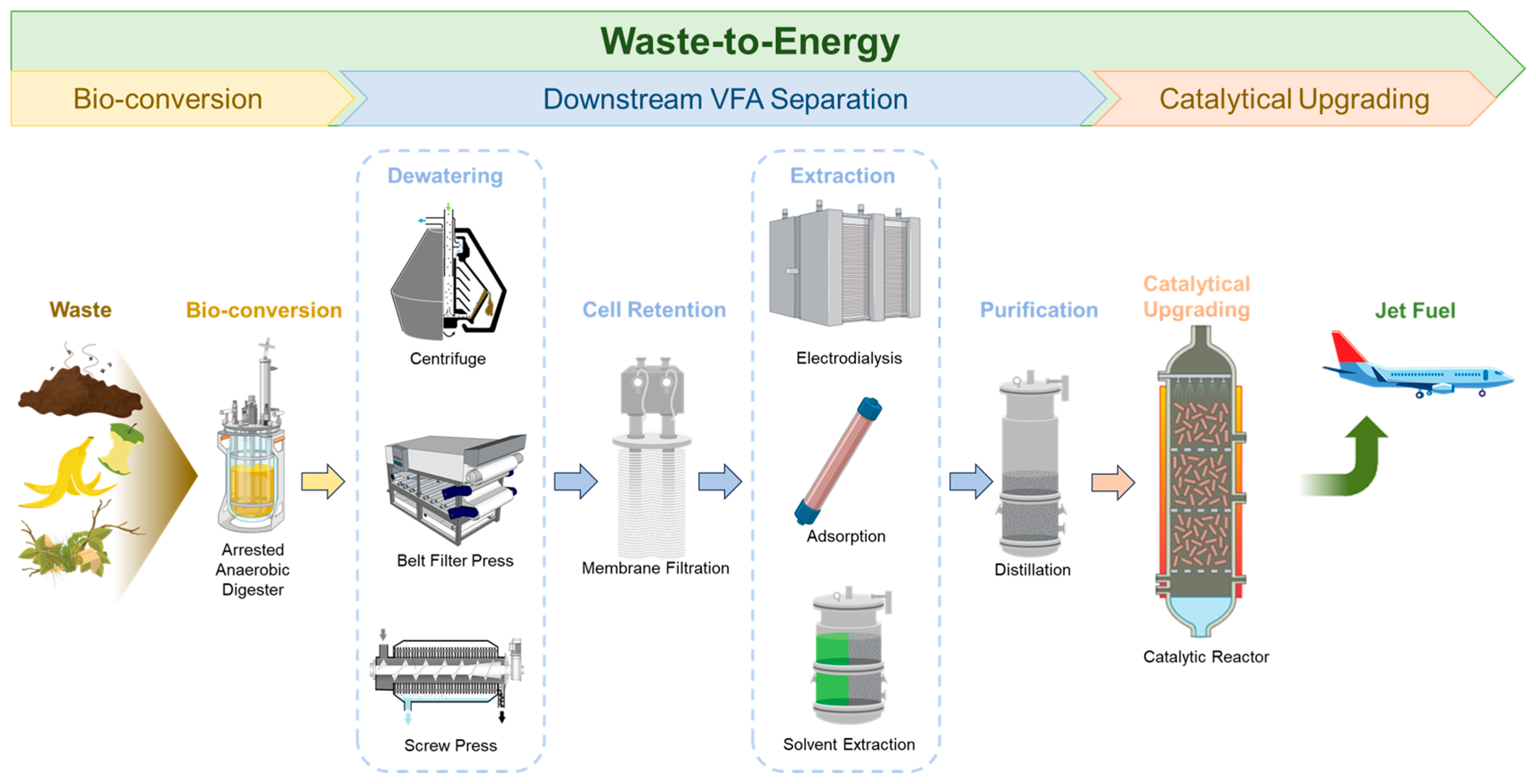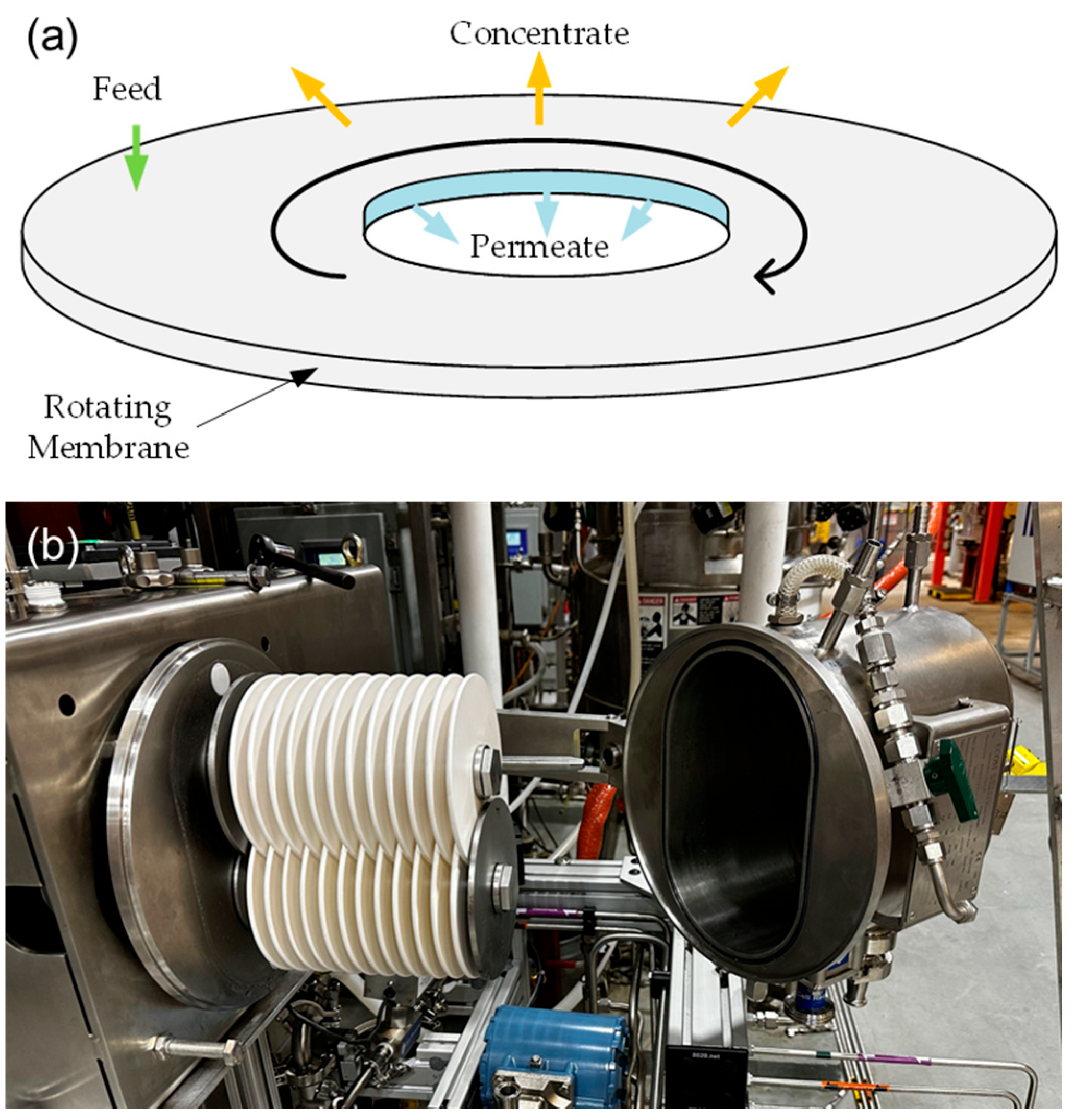Volatile Fatty Acid Recovery from Arrested Anaerobic Digestion for the Production of Sustainable Aviation Fuel: A Review
Abstract
:1. Introduction
2. Dewatering
2.1. Centrifuge
2.2. Belt Filter Press
2.3. Screw Press
2.4. Conditioning Technologies for Dewatering
2.4.1. Release of Interstitial Water and Bound Water
2.4.2. Coagulation and Flocculation
3. Membrane Filtration for Cell Retention
4. Extraction of VFAs
4.1. Electrodialysis
4.2. Adsorption
4.3. Liquid–Liquid Extraction (LLE)
- (1)
- Excellent selectivity in separating VFAs, with a notable separation factor;
- (2)
- A considerable partition coefficient, with a significant affinity for partitioning between the two liquid phases;
- (3)
- Good accessibility in large quantities and economic viability;
- (4)
- Non-toxicity to microorganisms and chemical inertness towards other nutrients and components present in the digestate;
- (5)
- Immiscibility with aqueous solutions and forms a distinct and clear phase separation;
- (6)
- Ability to be effectively recovered from the solvent, allowing for a regeneration and recycling process.
5. Perspectives on the Potential Role of VFAs in SAF Production
6. Conclusions
Author Contributions
Funding
Institutional Review Board Statement
Informed Consent Statement
Data Availability Statement
Conflicts of Interest
References
- IATA Net-Zero Carbon Emissions by 2050. 2021. Available online: https://www.iata.org/en/pressroom/pressroom-archive/2021-releases/2021-10-04-03/ (accessed on 3 July 2023).
- Holladay, J.; Abdullah, Z.; Heyne, J. Sustainable Aviation Fuel: Review of Technical Pathways Report. 2020. Available online: https://www.energy.gov/sites/default/files/2020/09/f78/beto-sust-aviation-fuel-sep-2020.pdf (accessed on 3 July 2023).
- Huq, N.A.; Hafenstine, G.R.; Huo, X.; Nguyen, H.; Tifft, S.M.; Conklin, D.R.; Stück, D.; Stunkel, J.; Yang, Z.; Heyne, J.S.; et al. Toward Net-Zero Sustainable Aviation Fuel with Wet Waste-Derived Volatile Fatty Acids. Proc. Natl. Acad. Sci. USA 2021, 118, e2023008118. [Google Scholar] [CrossRef] [PubMed]
- Grady, C.P.L.J.; Daigger, G.T.; Lim, H.C. Biological Wastewater Treatment, 2nd ed.; Marcel Dekker Inc.: New York, NY, USA, 1999; ISBN 0824789199. [Google Scholar]
- Rittmann, B.E.; McCarty, P.L. Environmental Biotechnology: Principles and Applications, 1st ed.; McGraw-Hill Education: New York, NY, USA, 2001; ISBN 0072345535. [Google Scholar]
- Wu, H.; Dalke, R.; Mai, J.; Holtzapple, M.; Urgun-Demirtas, M. Arrested Methanogenesis Digestion of High-Strength Cheese Whey and Brewery Wastewater with Carboxylic Acid Production. Bioresour. Technol. 2021, 332, 125044. [Google Scholar] [CrossRef]
- Zhu, X.; Leininger, A.; Jassby, D.; Tsesmetzis, N.; Ren, Z.J. Will Membranes Break Barriers on Volatile Fatty Acid Recovery from Anaerobic Digestion? ACS EST Eng. 2021, 1, 141–153. [Google Scholar] [CrossRef]
- Inyang, V.; Lokhat, D. Butyric Acid Reactive Extraction Using Trioctylamine in 1-Decanol: Response Surface Methodology Parametric Optimization Technique. Arab. J. Sci. Eng. 2021, 46, 6567–6577. [Google Scholar] [CrossRef]
- Tharani, D.; Ananthasubramanian, M. Process Intensification in Separation and Recovery of Biogenic Volatile Fatty Acid Obtained through Acidogenic Fermentation of Organics-Rich Substrates. Chem. Eng. Process.-Process. Intensif. 2021, 169, 108592. [Google Scholar] [CrossRef]
- Gössi, A.; Burgener, F.; Kohler, D.; Urso, A.; Kolvenbach, B.A.; Riedl, W.; Schuur, B. In-Situ Recovery of Carboxylic Acids from Fermentation Broths through Membrane Supported Reactive Extraction Using Membrane Modules with Improved Stability. Sep. Purif. Technol. 2020, 241, 116694. [Google Scholar] [CrossRef]
- Burgé, G.; Chemarin, F.; Moussa, M.; Saulou-Bérion, C.; Allais, F.; Spinnler, H.É.; Athès, V. Reactive Extraction of Bio-Based 3-Hydroxypropionic Acid Assisted by Hollow-Fiber Membrane Contactor Using TOA and Aliquat 336 in n-Decanol. J. Chem. Technol. Biotechnol. 2016, 91, 2705–2712. [Google Scholar] [CrossRef]
- Yang, S.T.; Huang, H.; Tay, A.; Qin, W.; Guzman, L.D.; Nicolas, E.C.S. Extractive Fermentation for the Production of Carboxylic Acids. In Bioprocessing for Value-Added Products from Renewable Resources: New Technologies and Applications; Elsevier: Amsterdam, The Netherlands, 2006. [Google Scholar]
- Burgé, G.; Moussa, M.; Athes-Dutour, V.; Saulou-Berion, C.; Spinnler, H.E. In Situ Extraction of 3-Hydroxyproionic Acid Assisted by Membrane Congractor. In Proceedings of the 4th International Congress on Green Process Engineering, Sevilla, Spain, 7–10 April 2014; Volume 3. [Google Scholar]
- Saboe, P.O.; Manker, L.P.; Michener, W.E.; Peterson, D.J.; Brandner, D.G.; Deutch, S.P.; Kumar, M.; Cywar, R.M.; Beckham, G.T.; Karp, E.M. In Situ Recovery of Bio-Based Carboxylic Acids. Green Chem. 2018, 20, 1791–1804. [Google Scholar] [CrossRef]
- Ramos-Suarez, M.; Zhang, Y.; Outram, V. Current Perspectives on Acidogenic Fermentation to Produce Volatile Fatty Acids from Waste. Rev. Environ. Sci. Biotechnol. 2021, 20, 439–478. [Google Scholar] [CrossRef]
- Ge, X.; Sheets, J.P.; Li, Y.; Mani, S. Algae-Based Feedstocks. In Bioenergy: Principles and Applications; Li, Y., Khanal, S.K., Eds.; Wiley-Blackwell: Hoboken, NJ, USA, 2016. [Google Scholar]
- Zhang, X.; Ye, P.; Wu, Y. Enhanced Technology for Sewage Sludge Advanced Dewatering from an Engineering Practice Perspective: A Review. J. Environ. Manag. 2022, 321, 115938. [Google Scholar] [CrossRef]
- Oshima, K.; Nakamura, K.; Guo, H.; Smith, R.L. Mini-Review on Application of Analytical Centrifugation, Ultracentrifugation and Centrifugal Devices to Phase Equilibria and Separation Processes. Fluid Phase Equilib. 2022, 558, 113457. [Google Scholar] [CrossRef]
- EPA. Biosolids Technology Fact Sheet: Belt Filter Press; EPA: Washington, DC, USA, 2000. Available online: https://www.epa.gov/sites/default/files/2018-11/documents/belt-filter-press-factsheet.pdf (accessed on 3 July 2023).
- Wakeman, R.J. Separation Technologies for Sludge Dewatering. J. Hazard. Mater. 2007, 144, 614–619. [Google Scholar] [CrossRef] [PubMed]
- El idrissi, B.; Loranger, É.; Lanouette, R.; Bousquet, J.P.; Martinez, M. Dewatering Parameters in a Screw Press and Their Influence on the Screw Press Outputs. Chem. Eng. Res. Des. 2019, 152, 300–308. [Google Scholar] [CrossRef]
- Cao, B.; Zhang, T.; Zhang, W.; Wang, D. Enhanced Technology Based for Sewage Sludge Deep Dewatering: A Critical Review. Water Res. 2021, 189, 116650. [Google Scholar] [CrossRef] [PubMed]
- Kang, X.; Li, C.; Ding, W.; Ma, Y.; Gao, S.; Zhou, X.; Chen, Y.; Liu, W.; Jiang, G. Optimization of Operating Conditions in the Biological Enzymes for Efficient Waste Activated Sludge Dewatering. Process Saf. Environ. Prot. 2023, 170, 545–552. [Google Scholar] [CrossRef]
- Suchecka, T.; Biernacka, E.; Piatkiewicz, W. Microorganism Retention on Microfiltration Membranes. Filtr. Sep. 2003, 40, 50–55. [Google Scholar] [CrossRef]
- Chen, Y. Performance Tuning of Ultrafiltration and Reverse Osmosis Membranes Surface Nano-Structured with Tethered Poly (Acrylic Acid) Chains. Ph.D. Thesis, UCLA, Los Angeles, CA, USA, 2022. [Google Scholar]
- Jaffrin, M.Y. Dynamic Filtration with Rotating Disks, and Rotating and Vibrating Membranes: An Update. Curr. Opin. Chem. Eng. 2012, 1, 171–177. [Google Scholar] [CrossRef]
- BOKELA BOKELA Filtration Technologies. Available online: http://www.bokela.de/de/technologien/cross-flow-filtration.html (accessed on 10 December 2022).
- Novoflow Dynamic Cross-Flow Filtration. Available online: https://www.novoflow.com/en/dynamische-cross-flow-filtration (accessed on 10 December 2022).
- Ding, L.; Jaffrin, M.Y.; Luo, J. Dynamic Filtration with Rotating Disks, and Rotating or Vibrating Membranes. In Progress in Filtration and Separation; Tarleton, S., Ed.; Elsevier: Amsterdam, The Netherlands, 2015; pp. 27–59. [Google Scholar]
- New Logic Research New Logic Research Technology. Available online: https://www.vsep.com/technology (accessed on 10 December 2022).
- DOE. High Solids In Situ Product Recovery. In The Next Generation of Arrested Anaerobic Digestion Technology; DOE: Washington, DC, USA. Available online: https://www.energy.gov/sites/default/files/2021-09/2396-1628_Quasar_Energy_Group_Summary.pdf#:~:text=High%20Solids%20In%20Situ%20Product%20Recovery%3B%20The%20Next,%3E%201%20kg%20of%20Sustainable%20Aviation%20Fuel%20%28SAF%29 (accessed on 3 July 2023).
- Teke, G.M.; Tai, S.L.; Pott, R.W.M. Extractive Fermentation Processes: Modes of Operation and Application. ChemBioEng Rev. 2022, 9, 146–163. [Google Scholar] [CrossRef]
- Giduthuri, A.T.; Ahring, B.K. Current Status and Prospects of Valorizing Organic Waste via Arrested Anaerobic Digestion: Production and Separation of Volatile Fatty Acids. Fermentation 2023, 9, 13. [Google Scholar] [CrossRef]
- Atasoy, M.; Owusu-Agyeman, I.; Plaza, E.; Cetecioglu, Z. Bio-Based Volatile Fatty Acid Production and Recovery from Waste Streams: Current Status and Future Challenges. Bioresour. Technol. 2018, 268, 773–786. [Google Scholar] [CrossRef]
- James, G.; Görgens, J.F.; Pott, R.W.M. Co-Production of Volatile Fatty Acids and Biogas from an Anaerobic Digestion System Using in Situ Extraction. Sep. Purif. Technol. 2021, 257, 117891. [Google Scholar] [CrossRef]
- Salvachúa, D.; Saboe, P.O.; Nelson, R.S.; Singer, C.; McNamara, I.; del Cerro, C.; Chou, Y.C.; Mohagheghi, A.; Peterson, D.J.; Haugen, S.; et al. Process Intensification for the Biological Production of the Fuel Precursor Butyric Acid from Biomass. Cell Rep. Phys. Sci. 2021, 2, 100587. [Google Scholar] [CrossRef]
- Chen, Y.; Saboe, P.; Kruger, J.; Hengge, N.; Berninghaus, A.; Nogue, V.S.I.; Karp, E.; Linger, J.; Beckham, G. Hydrophobic Polytetrafluoroethylene (PTFE) Membrane-Based Emulsion Separator for Butyric Acid Recovery from Clostridia Tyrobutyricum Fermentation Broth. In Proceedings of the 45th Symposium on Biomaterials, Fuels and Chemicals, SIMB, Portland, OR, USA, 30 April–3 May 2023. [Google Scholar]
- Zaiput Flow Technologies. Liquid-Liquid/Liquid-Gas Separators Providing in-Line Separation for Batch/Flow Chemistry; Zaiput Flow Technologies: Waltham, MA, USA, 2023; Available online: https://www.zaiput.com/technical_notes/Separators-TechnicalSpecification.pdf (accessed on 3 July 2023).






Disclaimer/Publisher’s Note: The statements, opinions and data contained in all publications are solely those of the individual author(s) and contributor(s) and not of MDPI and/or the editor(s). MDPI and/or the editor(s) disclaim responsibility for any injury to people or property resulting from any ideas, methods, instructions or products referred to in the content. |
© 2023 by the authors. Licensee MDPI, Basel, Switzerland. This article is an open access article distributed under the terms and conditions of the Creative Commons Attribution (CC BY) license (https://creativecommons.org/licenses/by/4.0/).
Share and Cite
Ge, X.; Chen, Y.; Sànchez i Nogué, V.; Li, Y. Volatile Fatty Acid Recovery from Arrested Anaerobic Digestion for the Production of Sustainable Aviation Fuel: A Review. Fermentation 2023, 9, 821. https://doi.org/10.3390/fermentation9090821
Ge X, Chen Y, Sànchez i Nogué V, Li Y. Volatile Fatty Acid Recovery from Arrested Anaerobic Digestion for the Production of Sustainable Aviation Fuel: A Review. Fermentation. 2023; 9(9):821. https://doi.org/10.3390/fermentation9090821
Chicago/Turabian StyleGe, Xumeng, Yian Chen, Violeta Sànchez i Nogué, and Yebo Li. 2023. "Volatile Fatty Acid Recovery from Arrested Anaerobic Digestion for the Production of Sustainable Aviation Fuel: A Review" Fermentation 9, no. 9: 821. https://doi.org/10.3390/fermentation9090821
APA StyleGe, X., Chen, Y., Sànchez i Nogué, V., & Li, Y. (2023). Volatile Fatty Acid Recovery from Arrested Anaerobic Digestion for the Production of Sustainable Aviation Fuel: A Review. Fermentation, 9(9), 821. https://doi.org/10.3390/fermentation9090821





